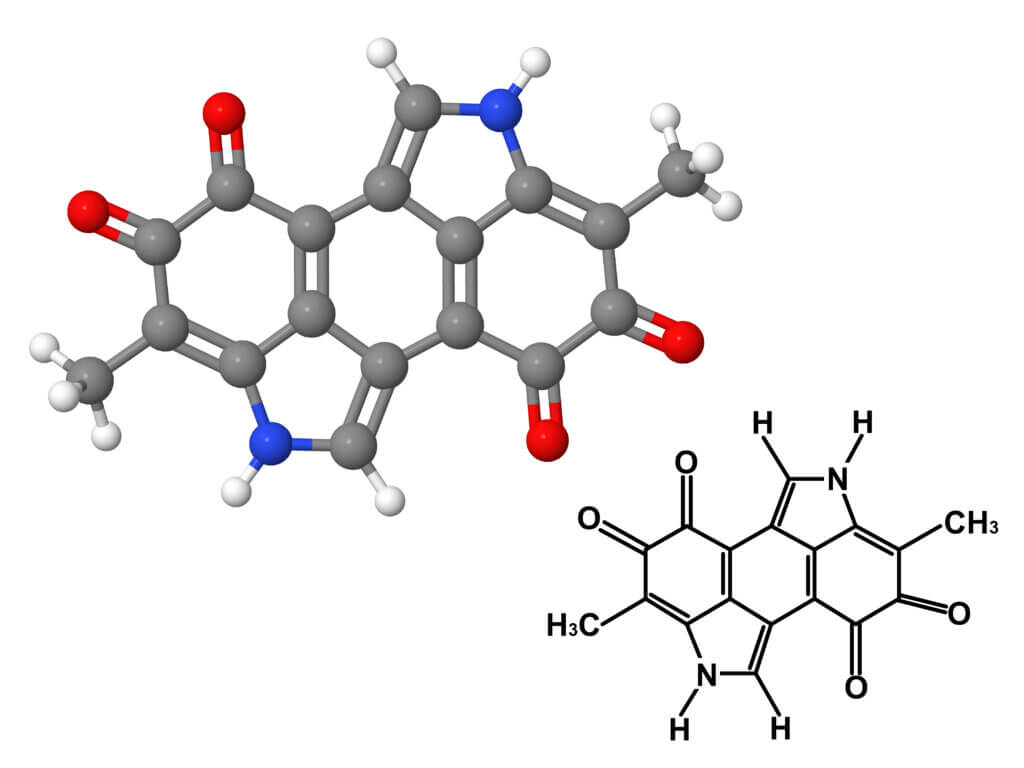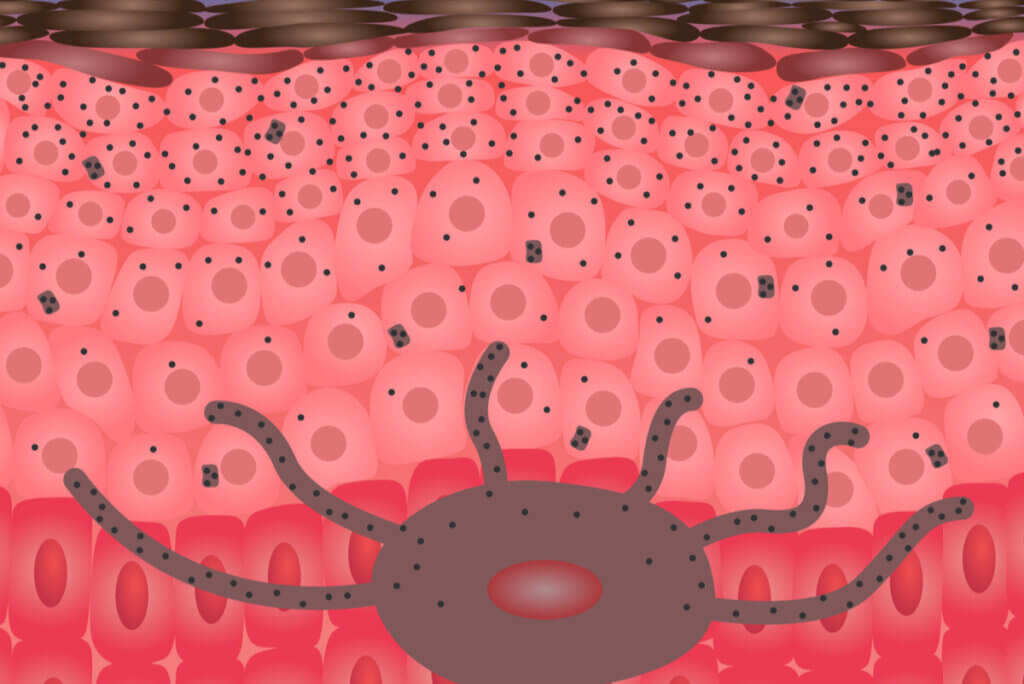All About Melanin


Escrito y verificado por el biólogo Samuel Antonio Sánchez Amador
Melanin is one of the most common pigments in nature. Not only is it found in human skin, but it’s also part of the color of eyes, hair, feathers, eggshells, the cuticle of many arthropods, and countless other biological structures.
Apart from the animal world, melanin can be produced by various microorganisms, such as Vibrio cholerae, Mycobacterium leprae, or Bacillus thurigiensis. From humans to bacteria, there’s no phylum that isn’t related in some way to this essential pigment.
In addition to this universal character, melanin is characterized by leading various pathologies in humans and other animals due to its excess (hyperpigmentation) or lack of it (hyperpigmentation). Of course, we’re dealing with a pigment of a multifaceted nature and, above all, of great medical and biological interest.
The chemical structure of melanin
First of all, it’s essential to contextualize this composite in a three-dimensional framework. To do this, we’ll describe its chemical structure in a few lines, based on various specialized portals.
As a first characteristic, we’re dealing with a biopolymer. This means that it’s a substance made up of macromolecules of an organic nature, which are linked to each other by covalent bonds —they join through their electrons in the last orbital.
Furthermore, melanins are rigid structures of conductive polymers composed of “black” polyacetylene, polypyrrole, and polyaniline and their blended polymers. We’ll limit ourselves to saying that polyacetylene is the simplest type of melanin.
We can imagine this compound-complex as a series of “cells” in the shape of a honeycomb. Although it may be difficult to get an idea of the three-dimensional nature of this polymer, we can use research portals such as Pubchem that show us its structure interactively.
Main types
The different melanins are associated, forming complex combinations, which gives rise to the different tones and shades of skin color, among many other structures. According to scientific journals, there are two main types:
- Eumelanins: Black or brownish in color, contain sulfur in their chemical composition, giving dark tones. Its concentration gives rise to black, blonde, or brown hair colors, for example.
- Feomelanins: Yellow or red pigments that contain a higher proportion of sulfur than the previous ones. Pheomelanin is expressed in humans in low eumelanin environments and is responsible for freckles, to cite one example.
In general, it can be said that the more eumelanin added to a tissue, the darker it will appear, while the higher the pheomelanin concentration, the lighter it will be. All of these values are subject to change, as melanin production can vary with age.

Melanocytes
We can’t continue without talking about melanocytes, the cells specialized in the production of melanin. According to studies, they account for up to 5% of the population of epidermal cells, which is why they’re represented in the skin.
We’re dealing with a dendritic cell (with immune functions) with clear cytoplasm and a small, ovoid nucleus. In addition, it presents various cytoplasmic projections in order to interact with other epithelial cells at the same time.
Finally, as far as structure is concerned, it should be noted that within the melanocytes we find the melanosomes. These are organelles delimited by a lipid membrane; a structure in which we find melanin.
Apart from pigmentation, melanocytes also actively participate in the immune system. In addition to being part of the primary physical barrier, that is, the skin, these cells have been observed to produce signaling molecules directed at various immune cells —proinflammatory cytokines or chemokines, for example.
Melanin biosynthesis
The cells just described form in the neural crest and, during embryonic development, migrate to the epidermis and hair follicles. Melanocytes are responsible for producing the pigment that concerns us here through a process called melanogenesis.
Tyrosine, one of the 20 protein-building amino acids, is required for this process. In summary, various enzyme-mediated oxidations of tyrosine occur, a process that gives rise to DOPA —dihydroxyphenylalanine—.
After this, dopaquinone is generated, a common compound that will be the direct precursor of eumelanin or pheomelanin, from two different pathways. In short, we’re dealing with a complex chemical process directly mediated by melanocytes.

Melanin function
It’s difficult to cover the function of melanin in a few lines, as it has many uses. Even so, we can summarize the protective effect of this pigment against UV light in the following lines:
- Melanogenesis occurs in the deepest layer of the epidermis —basal layer— and in the cells of the hair follicle matrix.
- Its synthesis is stimulated by exposure to ultraviolet (UV) radiation. Melanin protects the DNA of keratinocytes—dominant cells in the epidermis—from said electromagnetic radiation.
- Melanin absorbs harmful ultraviolet radiation and transforms it into heat energy through ultra-fast conversion.
- This allows the pigment to dissipate more than 99.9% of the absorbed radiation as heat – harmless in nature.
This functionality is of vital importance, because ultraviolet radiation from the sun can destroy cellular DNA and predispose to carcinogenic processes. Such is the danger of this mutagenic potential that some cells have been found to “commit suicide” lest they perpetuate these deleterious sun-induced defects.
In any case, experts theorize that melanin has specific functions depending on the organism that produces it. For example, this pigment protects Vibrio bacteria from thermal and hyperosmolar shock in estuaries, making them resistant to various harsh environments.
It’s also surprising to learn that various phytopathogenic fungi —that attack plants— require melanins to cause diseases. This promotes the hypothesis that the pigment is related to virulence for plant pathogens.
Melanin and the human being
Apart from the individual protective function, it’s clear that this pigment has aesthetic value in general society. It should be noted that the different ethnicities of the world have approximately the same number of melanocytes, but people with darker skin tones have greater cell activity.
Even so, the distribution of this pigment isn’t the same throughout the body:
- On the face and scalp we have about 2000 melanocytes per square millimeter.
- The genital area is the area most populated by this cell type, since we can observe about 2400 melanocytes per square millimeter.
- The trunk and extremities have a lower value, approximately 1500 cell bodies per square millimeter.
- Melanin is also found beyond the skin: It’s present in the lining of the retina, the medulla and zona reticularis of the adrenal gland, the inner ear, the substantia nigra, and the blue spot of the brain or locus ceruleus.
In addition, it should be noted that melanin not only varies spatially, but also on a temporal scale. Studies already cited underline that human beings lose 10% of melanocytes for each decade of life. When the stem cells of the melanocytes of the hair follicle break down, the famous gray hairs appear.

Melanin and diseases
According to medical portals such as the United States National Library of Medicine, there are various pathologies of a pigmentary nature. Some of these syndromes and conditions can affect localized regions and others the entire body. Here’s a short list of some of them:
- Melanoma: This is the most serious type of skin cancer. Melanocytes, due to mutations in their DNA, grow uncontrollably and form a mass. It’s believed that excessive exposure to UV radiation can promote the appearance of this type of tumor.
- Albinism: Although there are many types, it can be summarized as a condition characterized by the absence or decrease of melanin pigment in the skin, eyes, and hair. It’s estimated to affect 1 in 20,000 people.
- Dyschromias: Physiological or pathological alterations of the normal color of the skin. An increase in melanin production by existing melanocytes or increased proliferation of active melanocytes can cause dark spots on the skin.
- Melasma: This is an acquired hyper melanosis of the skin, especially in pregnant women. It’s believed that the overproduction of melanocyte-stimulating hormones due to stress may be part of the cause.
As we have seen, there are multiple pathologies directly linked to the production of melanin and melanocytes. Even so, the presence of abnormally pigmented skin doesn’t always lie in this pigment, since it’s normal for certain areas to darken after inflammatory processes.
An essential pigment
As we have seen, melanin is a pigment that goes far beyond the color of hair or eyes. It protects us from the harmful effects of UV light, it’s present in certain areas of the brain, and some microorganisms use it to survive in extreme environments.
We have integrated an excellent protector against environmental inclemencies, but that doesn’t mean that we’re exempt from danger. Many experts warn us that skin cancer and the sun are closely related. Therefore, despite this great protection mechanism, it’s essential to become aware.
Melanin is one of the most common pigments in nature. Not only is it found in human skin, but it’s also part of the color of eyes, hair, feathers, eggshells, the cuticle of many arthropods, and countless other biological structures.
Apart from the animal world, melanin can be produced by various microorganisms, such as Vibrio cholerae, Mycobacterium leprae, or Bacillus thurigiensis. From humans to bacteria, there’s no phylum that isn’t related in some way to this essential pigment.
In addition to this universal character, melanin is characterized by leading various pathologies in humans and other animals due to its excess (hyperpigmentation) or lack of it (hyperpigmentation). Of course, we’re dealing with a pigment of a multifaceted nature and, above all, of great medical and biological interest.
The chemical structure of melanin
First of all, it’s essential to contextualize this composite in a three-dimensional framework. To do this, we’ll describe its chemical structure in a few lines, based on various specialized portals.
As a first characteristic, we’re dealing with a biopolymer. This means that it’s a substance made up of macromolecules of an organic nature, which are linked to each other by covalent bonds —they join through their electrons in the last orbital.
Furthermore, melanins are rigid structures of conductive polymers composed of “black” polyacetylene, polypyrrole, and polyaniline and their blended polymers. We’ll limit ourselves to saying that polyacetylene is the simplest type of melanin.
We can imagine this compound-complex as a series of “cells” in the shape of a honeycomb. Although it may be difficult to get an idea of the three-dimensional nature of this polymer, we can use research portals such as Pubchem that show us its structure interactively.
Main types
The different melanins are associated, forming complex combinations, which gives rise to the different tones and shades of skin color, among many other structures. According to scientific journals, there are two main types:
- Eumelanins: Black or brownish in color, contain sulfur in their chemical composition, giving dark tones. Its concentration gives rise to black, blonde, or brown hair colors, for example.
- Feomelanins: Yellow or red pigments that contain a higher proportion of sulfur than the previous ones. Pheomelanin is expressed in humans in low eumelanin environments and is responsible for freckles, to cite one example.
In general, it can be said that the more eumelanin added to a tissue, the darker it will appear, while the higher the pheomelanin concentration, the lighter it will be. All of these values are subject to change, as melanin production can vary with age.

Melanocytes
We can’t continue without talking about melanocytes, the cells specialized in the production of melanin. According to studies, they account for up to 5% of the population of epidermal cells, which is why they’re represented in the skin.
We’re dealing with a dendritic cell (with immune functions) with clear cytoplasm and a small, ovoid nucleus. In addition, it presents various cytoplasmic projections in order to interact with other epithelial cells at the same time.
Finally, as far as structure is concerned, it should be noted that within the melanocytes we find the melanosomes. These are organelles delimited by a lipid membrane; a structure in which we find melanin.
Apart from pigmentation, melanocytes also actively participate in the immune system. In addition to being part of the primary physical barrier, that is, the skin, these cells have been observed to produce signaling molecules directed at various immune cells —proinflammatory cytokines or chemokines, for example.
Melanin biosynthesis
The cells just described form in the neural crest and, during embryonic development, migrate to the epidermis and hair follicles. Melanocytes are responsible for producing the pigment that concerns us here through a process called melanogenesis.
Tyrosine, one of the 20 protein-building amino acids, is required for this process. In summary, various enzyme-mediated oxidations of tyrosine occur, a process that gives rise to DOPA —dihydroxyphenylalanine—.
After this, dopaquinone is generated, a common compound that will be the direct precursor of eumelanin or pheomelanin, from two different pathways. In short, we’re dealing with a complex chemical process directly mediated by melanocytes.

Melanin function
It’s difficult to cover the function of melanin in a few lines, as it has many uses. Even so, we can summarize the protective effect of this pigment against UV light in the following lines:
- Melanogenesis occurs in the deepest layer of the epidermis —basal layer— and in the cells of the hair follicle matrix.
- Its synthesis is stimulated by exposure to ultraviolet (UV) radiation. Melanin protects the DNA of keratinocytes—dominant cells in the epidermis—from said electromagnetic radiation.
- Melanin absorbs harmful ultraviolet radiation and transforms it into heat energy through ultra-fast conversion.
- This allows the pigment to dissipate more than 99.9% of the absorbed radiation as heat – harmless in nature.
This functionality is of vital importance, because ultraviolet radiation from the sun can destroy cellular DNA and predispose to carcinogenic processes. Such is the danger of this mutagenic potential that some cells have been found to “commit suicide” lest they perpetuate these deleterious sun-induced defects.
In any case, experts theorize that melanin has specific functions depending on the organism that produces it. For example, this pigment protects Vibrio bacteria from thermal and hyperosmolar shock in estuaries, making them resistant to various harsh environments.
It’s also surprising to learn that various phytopathogenic fungi —that attack plants— require melanins to cause diseases. This promotes the hypothesis that the pigment is related to virulence for plant pathogens.
Melanin and the human being
Apart from the individual protective function, it’s clear that this pigment has aesthetic value in general society. It should be noted that the different ethnicities of the world have approximately the same number of melanocytes, but people with darker skin tones have greater cell activity.
Even so, the distribution of this pigment isn’t the same throughout the body:
- On the face and scalp we have about 2000 melanocytes per square millimeter.
- The genital area is the area most populated by this cell type, since we can observe about 2400 melanocytes per square millimeter.
- The trunk and extremities have a lower value, approximately 1500 cell bodies per square millimeter.
- Melanin is also found beyond the skin: It’s present in the lining of the retina, the medulla and zona reticularis of the adrenal gland, the inner ear, the substantia nigra, and the blue spot of the brain or locus ceruleus.
In addition, it should be noted that melanin not only varies spatially, but also on a temporal scale. Studies already cited underline that human beings lose 10% of melanocytes for each decade of life. When the stem cells of the melanocytes of the hair follicle break down, the famous gray hairs appear.

Melanin and diseases
According to medical portals such as the United States National Library of Medicine, there are various pathologies of a pigmentary nature. Some of these syndromes and conditions can affect localized regions and others the entire body. Here’s a short list of some of them:
- Melanoma: This is the most serious type of skin cancer. Melanocytes, due to mutations in their DNA, grow uncontrollably and form a mass. It’s believed that excessive exposure to UV radiation can promote the appearance of this type of tumor.
- Albinism: Although there are many types, it can be summarized as a condition characterized by the absence or decrease of melanin pigment in the skin, eyes, and hair. It’s estimated to affect 1 in 20,000 people.
- Dyschromias: Physiological or pathological alterations of the normal color of the skin. An increase in melanin production by existing melanocytes or increased proliferation of active melanocytes can cause dark spots on the skin.
- Melasma: This is an acquired hyper melanosis of the skin, especially in pregnant women. It’s believed that the overproduction of melanocyte-stimulating hormones due to stress may be part of the cause.
As we have seen, there are multiple pathologies directly linked to the production of melanin and melanocytes. Even so, the presence of abnormally pigmented skin doesn’t always lie in this pigment, since it’s normal for certain areas to darken after inflammatory processes.
An essential pigment
As we have seen, melanin is a pigment that goes far beyond the color of hair or eyes. It protects us from the harmful effects of UV light, it’s present in certain areas of the brain, and some microorganisms use it to survive in extreme environments.
We have integrated an excellent protector against environmental inclemencies, but that doesn’t mean that we’re exempt from danger. Many experts warn us that skin cancer and the sun are closely related. Therefore, despite this great protection mechanism, it’s essential to become aware.
- Melanina, química.es. Recogido a 21 de octubre en https://www.quimica.es/enciclopedia/Melanina.html#:~:text=Las%20melaninas%20son%20estructuras%20r%C3%ADgidas,melaninas%20fungales%20son%20poliacetileno%20puro.
- Melanin, pubchem.com. Recogido a 21 de octubre en https://pubchem.ncbi.nlm.nih.gov/compound/Melanin#section=3D-Conformer&fullscreen=true
- Schadendorf, Dirk, et al. “Melanoma.” The Lancet 392.10151 (2018): 971-984.
- Cetina, Jorge Tello, et al. “Uso de la melanina del pulpo (Octopus maya) de Yucatán como agente antibacteriano.” Revista Cubana de Investigaciones Pesqueras 35.1 (2018): 0138-8452.
- Marín, D., & del Pozo, A. (2005). Pigmentación de la piel (I). Melaninas: conceptos generales e implicaciones cosméticas. Offarm: farmacia y sociedad, 24(1), 116-118.
- Cifuentes-Tang, L., & Victoria, J. (2020). La biología del melanocito y su papel en la respuesta inmunitaria cutánea. Dermatología Revista Mexicana, 63(5), 534-538.
- Científicos descubren cómo la radiación ultravioleta hace que las células mueran para evitar el daño provocado por el cáncer, hhmi. Recogido a 21 de octubre en https://www.hhmi.org/news/cient-ficos-descubren-c-mo-la-radiaci-n-ultravioleta-hace-que-las-c-lulas-mueran-para-evitar-el#:~:text=La%20radiaci%C3%B3n%20ultravioleta%20del%20sol,el%20desarrollo%20subsecuente%20de%20c%C3%A1ncer.&text=La%20radiaci%C3%B3n%20ultravioleta%20(UV)%20del,el%20desarrollo%20subsecuente%20de%20c%C3%A1ncer.
- Trastornos de pigmentación de la piel, medlineplus.gov. Recogido a 21 de octubre en https://medlineplus.gov/spanish/skinpigmentationdisorders.html#:~:text=Si%20el%20cuerpo%20produce%20demasiada,causa%20%C3%A1reas%20de%20piel%20clara.
- Martín, Lorenzo, and María del Carmen. “Albinismo: tipos, etiología, nuevas perspectivas terapéuticas.” (2018).
- Sol y cancer de piel, aecc. Recogido a 21 de octubre en https://www.aecc.es/es/todo-sobre-cancer/prevencion/evita-exposicion-sol/sol-cancer-piel
Este texto se ofrece únicamente con propósitos informativos y no reemplaza la consulta con un profesional. Ante dudas, consulta a tu especialista.







